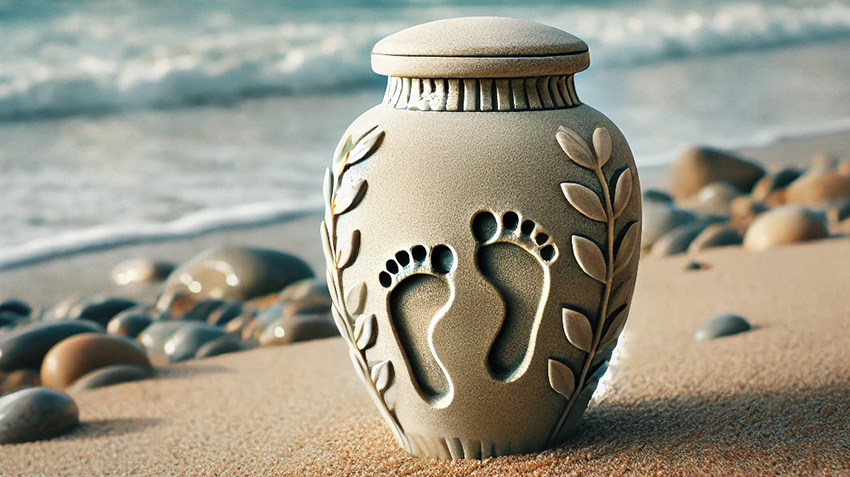
As the world moves toward more sustainable practices, even end-of-life services are evolving.
One such practice gaining traction in the United States is eco-friendly cremation, also called sustainable cremation. According to the National Funeral Directors Association’s 2024 Consumer Awareness and Preferences Report, 68% of people expressed interest in exploring “green” funeral options because of their potential environmental benefits.
For families seeking a greener way to honor their loved ones, sustainable cremation offers a thoughtful alternative to traditional methods. In this post, we’ll explore what sustainable cremation is, its methods, benefits, challenges, and how to choose the right provider.
What is sustainable cremation?
Sustainable cremation is an environmentally responsible alternative to traditional cremation or burial, focused on reducing the environmental impact of the process. Traditional cremation, while offering a means of handling remains, uses large amounts of energy and releases harmful emissions, including carbon dioxide. In contrast, eco-friendly cremation methods aim to minimize these environmental costs by utilizing innovative technology that reduces carbon footprints and preserves natural resources.
There are key differences between traditional and sustainable cremation processes. Traditional cremation involves burning the body in a furnace at high temperatures, which consumes large amounts of fuel and releases pollutants into the air. In contrast, sustainable cremation focuses on reducing energy usage and the emission of toxins, offering a gentler, more sustainable option.
The most popular methods of sustainable cremation include alkaline hydrolysis and natural organic reduction (NOR), both of which offer a greener alternative to the traditional cremation process.
Methods of sustainable cremation
The following are some examples of sustainable cremation:
Alkaline hydrolysis (Water cremation)
One of the most talked-about methods of sustainable cremation is alkaline hydrolysis, also known as water cremation. This process uses water, heat, and alkaline chemicals to break down the body, turning it into a liquid and leaving behind only the bones, which are then processed into a fine powder. The result is an environmentally friendly process that significantly reduces energy consumption and carbon emissions compared to traditional cremation.
Currently, alkaline hydrolysis is legal in several states, including California, Oregon, and Colorado. However, it is not yet widely available across the country due to legal restrictions, and ongoing legislative efforts are being made to expand its availability.
Natural organic reduction (NOR) or human composting
Another growing trend in sustainable cremation is natural organic reduction, also known as human composting. This process involves decomposing human remains into nutrient-rich soil through a controlled, aerobic process. The body is placed in a container with organic materials like straw and wood chips, and over several weeks, the body naturally breaks down into soil. This method preserves natural resources by transforming the body into compost that can enrich the earth.
At present, several states, including Washington, Colorado, and Oregon, have legalized human composting. Like alkaline hydrolysis, it is still relatively new and not yet available everywhere, though its legal footprint is expanding.
Comparison: Alkaline hydrolysis vs. natural organic reduction
Both alkaline hydrolysis and NOR are considered much more environmentally friendly than traditional cremation. On the one hand, when comparing the two methods, alkaline hydrolysis uses less energy and releases fewer emissions than the high-temperature flames of traditional cremation. On the other hand, natural organic reduction further reduces environmental impact by creating beneficial compost, which can be used to enrich the land, further contributing to sustainability.
While both methods offer a reduction in carbon footprints and the elimination of harmful emissions, NOR goes a step further by providing families with a lasting legacy in the form of soil, potentially for planting trees or creating memorial gardens.
Benefits of sustainable cremation
The appeal of sustainable cremation lies not only in its environmental benefits but also in its alignment with the personal and ethical values of many individuals. One significant benefit is the reduction in carbon footprint. Sustainable cremation uses much less energy compared to traditional methods, which helps to decrease greenhouse gas emissions and air pollution.
Another benefit is the elimination of harmful chemicals, such as mercury from dental fillings, which can be released into the atmosphere during traditional cremation. By opting for sustainable cremation, families can ensure that their loved one’s remains are treated in a way that does not contribute to environmental pollution.
Furthermore, eco-friendly cremation helps preserve natural resources, such as land, which is often used for traditional burial. In areas with limited land availability, eco-friendly methods can help alleviate the pressure on burial spaces and reduce the strain on natural ecosystems.
Most importantly, sustainable cremation resonates with individuals who prioritize sustainability and wish to make a positive environmental impact even after death. For these individuals, this method provides a meaningful way to align their end-of-life choices with their broader ethical values.
Challenges and considerations
Despite its benefits, sustainable cremation does face some challenges. One of the most significant barriers is the legal restrictions around its availability. While alkaline hydrolysis and NOR are legal in select states, these methods are not universally available across the U.S. Efforts to expand the legality of these methods are ongoing, but families interested in sustainable cremation may have to travel to a state where the process is permitted.
Another challenge is the cost. Eco-friendly cremation methods are often more expensive than traditional cremation due to the specialized equipment and technology required. For some families, this cost difference may be a consideration when making their decision.
Also, public awareness and misconceptions about sustainable cremation remain obstacles. Some individuals may be hesitant to choose these newer methods because they are unfamiliar with the process or misunderstand how they work. Education and advocacy efforts are crucial to overcoming these barriers and making sustainable cremation more widely accepted.
How to choose sustainable cremation services
If you’re interested in sustainable cremation, it’s important to research service providers that offer these options. Start by looking for funeral homes or cremation providers that advertise green burial or cremation services. When contacting funeral homes, be sure to ask specific questions about the eco-friendly options they provide, including whether they offer alkaline hydrolysis or natural organic reduction.
It’s also important to communicate your wishes to your family in advance. Pre-planning your funeral arrangements can help ensure that your environmental values are respected, and it can relieve your family of the burden of making these decisions during a difficult time.
Frequently Asked Questions
Below are some commonly asked questions to consider:
1. What is the environmental impact of traditional cremation compared to sustainable cremation?
Traditional cremation releases harmful emissions and uses significant energy. Eco-friendly cremation methods, like alkaline hydrolysis and natural organic reduction, use less energy and produce fewer emissions, reducing their overall environmental impact.
2. How can I find a funeral provider that offers sustainable cremation services?
Look for funeral homes that advertise green or eco-friendly services, and be sure to ask about specific methods like alkaline hydrolysis or human composting.
3. Is sustainable cremation available everywhere?
No, sustainable cremation is currently legal in only a few states. It’s important to check the laws in your state and consider options in nearby states if needed.
The future of eco-friendly cremation in the U.S.
As awareness of environmental issues grows, sustainable cremation is likely to see broader adoption in the U.S. Innovations in technology and an increasing focus on sustainability will continue to shape the future of end-of-life services.
Speak to a professional cremation services provider about sustainable cremation options today.



